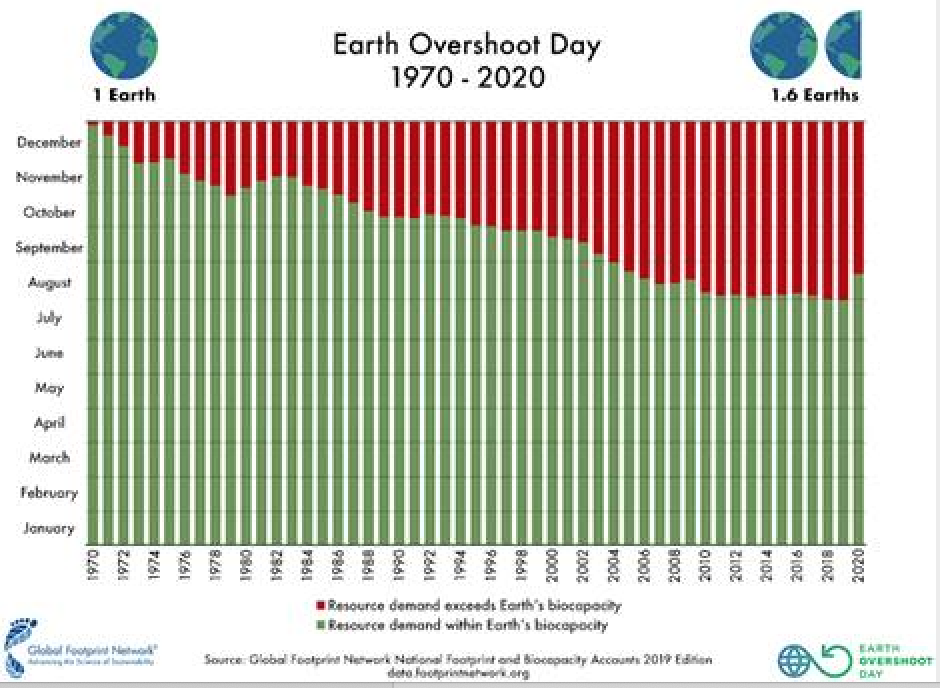Client Affairs
Investing In The Planet: A 2020 Turning Point?

The shutdown earlier this year cut Earth's ecological footprint by nearly 10 per cent. This was bad news for the global economy but good news for "Earth Overshoot Day" which passed at the weekend, registering how much we consume over what the planet can deliver. Consumption will drive recovery - this guest article argues there is a clear path from the consumption conundrum.
For those unfamiliar, Earth Overshoot Day is the annual milestone on which the planet has out-consumed its ecological capacity for the year. Last year’s Earth Overshoot Day occurred on July 29, the earliest date ever. This year it landed a full three weeks later on August 22. A good result for Mother Earth. At the current pace, humans are using natural resources 1.6 times faster than ecosystems can replenish them. Ever since the milestone was conceived in the 1970s, it has crept up the calendar year and reflects what the relentless demand for “stuff” places on the planet. If 2020 does have a silver lining, it was giving Earth a few weeks off from "us".
While not entirely cause for celebration, the overshoot data is an opportunity "to rebuild society with a greater focus on sustainability," observes Ben Constable Maxwell. The head of sustainable and impact investing at M&G Investments outlines what continuing progress requires of investors and consumers to keep drawing down this deficit and turn a corner. His note is a timely one in thinking about care of the planet and where we are in our own adjustments. We welcome external guest features, where the usual editorial disclaimers apply. Send feedback to tom.burroughes@wealthbriefing.com and jackie.bennion@clearviewpublishing.com. Further resources on individual country footprints and how they are scored can be found here.
The effective shutdown of the global economy, induced by the coronavirus pandemic, reduced humanity’s ecological footprint by 9.3 per cent, according to estimates from the Global Footprint Network, which calculates the day every year.
It is increasingly commonplace to talk about the ‘carbon budget’ we need to adhere to if we are to keep global temperature rises to well below the 2° Celsius level at which ‘catastrophic and irreversible’ (according to the United Nations) climate change becomes inevitable. The estimated limit is 450 ppm (parts per million) of carbon dioxide equivalent in the atmosphere, and we are currently at the record level of 417 ppm – and rising.
Earth Overshoot Day is important because it represents the broader ‘resource budget’ that we have left to spend, covering all the natural resources that we use up every year. This includes diminishing reserves of oil and gas, minerals like copper and iron ore, and productive land on which we can grow crops.

It also captures the atmosphere’s capacity to absorb greenhouse gas emissions; the ocean’s capacity to avoid dangerous acidification as it warms; and the capacity of tropical rainforests – the lungs of the earth – to cope with logging and exploitation of natural resources. And the list goes on.
Plastic pollution is one of the many symptoms of our overuse of natural resources. A recent study sponsored by the Pew Charitable Trusts and Systemiq [1] suggests ocean plastic could triple by 2040 and recommends switching to biodegradable and compostable alternatives for certain packaging – supporting organic carbon replenishment. The world produces around 359 million metric tons of plastics each year, with only about 9 per cent being recycled. Much of the rest leaks into the environment, with the result that by 2050 there will be a greater weight of plastic in the ocean than fish.
And on climate change, the landmark IPCC report from 2019 highlighted in stark terms that we have only ten years to transform our industrial and energy systems, otherwise we will reach the limit of our ability to slow global heating in any meaningful way.
So what are the solutions to
#movethedate back towards December?
As individuals, there are steps we can all take – drive less, fly
less, eat less meat, recycle more, and importantly use less
stuff. We also need to waste less. Taking one example, 700
million people around the world are food insecure, and yet 30 per
cent of food production is wasted, either in the agricultural
process or by consumers [2].
While consumer behaviour is crucial, business and investors also have role to play. As investors, we can also look to companies that provide the solutions to some of these challenges.
French engineering business Schneider Electric is one example. It combines world-leading energy technologies and real time automation, and pioneering software into integrated solutions to improve the efficiency and sustainability of homes, buildings, data centres, infrastructure and industries. The four key markets Schneider serves consume 70 per cent of the world’s energy. By making those areas operate more efficiently, using its technologies for buildings, industrial processes, and electricity production, the company recognises it can be a huge part of the solution. Indeed, the company is explicit about its strategy to ‘move humanity out of ecological overshoot’. According to their analysis in 2019, “by applying existing technology worldwide in these arenas alone, the energy retrofit and the decarbonization of electricity generation combined would move the date by 21 days.”
UK paper and packaging business DS Smith is demonstrating how the circular economy model can reduce the ecological footprint of industrial processes. The company uses 100 per cent recycled and sustainably sourced materials to make its cardboard packaging and the 6 million tonnes of recyclable material that it collected, sorted and reprocessed in 2019 outweighed the amount of packaging put on the market that year [3]. The company has an established partnership with the Ellen Macarthur Foundation – the world’s leader in promoting circularity – and together they have announced a set of Circular Design Principles, highlighting how crucial sustainable design is in the battle to eliminate waste.
Grounds for optimism – and ambition
Companies like these highlight that Earth Overshoot is not
inevitable, and can be pushed back towards our ecological
boundaries without leaving people worse off.
If we are to successfully embrace a more circular, more efficient and less wasteful economic model, I believe there needs to be a system-level approach. The European Union’s Circular Economy action plan sets an example for others to follow, with policies supporting sustainable production, waste reduction and the decoupling of growth from resource extraction. At a city level, both Amsterdam and Copenhagen are adopting Kate Raworth’s ‘Doughnut Economics’ model [4] which focuses on ensuring social support for the population’s needs while not transgressing important environmental and ecological thresholds. It is a model for a more sustainable and regenerative economy, one which ascribes greater value to societal wellbeing and environmental resilience.
The most often quoted definition of sustainability comes from the UN World Commission on Environment and Development: “Sustainable development is development that meets the needs of the present without compromising the ability of future generations to meet their own needs”.
Despite the encouraging fact that Earth Overshoot Day can move backwards in the year, that we are only in August is an urgent reminder of our failure to deliver on this societal pact with future generations, and with nature itself.
[1]
https://www.pewtrusts.org/-/media/assets/2020/07/breakingtheplasticwave_summary.pdf
[2]
https://www.unenvironment.org/thinkeatsave/get-informed/worldwide-food-waste
https://ourworldindata.org/hunger-and-undernourishment
[3]
https://www.dssmith.com/company/sustainability/sustainabilityreport
[4]
https://upload.wikimedia.org/wikipedia/commons/1/12/Doughnut_%28economic_model%29.jpg